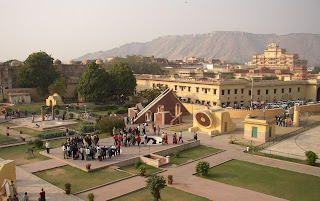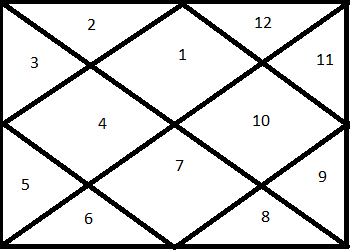Indian Concept of Time
The word 'Kala' in Sanskrit language means time. It means the force which has the power to destroy all objects in the universe. It also signifies the past present and future. Hindus have peculiar division of time. The reckoning of time ranges from a 'Yuga' to 'Tatpara'. The Hindus consider 4 yugas viz. 1) Satya yuga 2) Treta yuga 3) Dwapar yuga 4) Kali yuga. The duration of kali yuga is said to be of 432000 years. The duration of Dwapar yuga, Treta yuga and Satya Yuga is twice, thrice and four times of Kali Yuga respectively. The Hindus considered the commencement of Kali Yuga in 3102 BC.
Sixty year cycle
The
Hindu’s have also considered the cycle of sixty lunar years for the purpose of
reckoning time. This is usually used for predicting mundane events. Let us
first understand the ‘Vedic time cycle’. There are sixty years in one cycle,
which are again sub-divided into twelve parts called as 'Yugas' (Note that the
term yuga used here differs from the term ‘Yuga’ used earlier. For e.g. Kali
yuga.) so that every Yuga is of five years. For each such Yuga lordship is
assigned to various Hindu deities. The Lords of twelve Yugas are as follows
1) Vishnu(controller of universe)
2) Jupiter
3) Indra(lord of rains)
4) Agni(fire)
5) Brahma(Creator)
6) Shiva(destroyer)
7) Pitara(ancestors)
8) Vishvedeva
9) Moon
10) Agni(fire)
11)Ashvinikumar(divine physicians )
12) Sun.
2) Jupiter
3) Indra(lord of rains)
4) Agni(fire)
5) Brahma(Creator)
6) Shiva(destroyer)
7) Pitara(ancestors)
8) Vishvedeva
9) Moon
10) Agni(fire)
11)Ashvinikumar(divine physicians )
12) Sun.
The first year in every Yuga is called as 'Samvatsara'.
Each Samvatsara is supposed to be ruled by a deity. The deities of 5
years in each yuga are as follows.
For First year called as Samvatsara the lord is Agni
For Second year called as Parivatsara the lord is Sun
For Third year called as Edavatsara the lord is Moon
For Fourth year called as Anuvatsara the lord is Brahma
For Fifth year called as Edwatsara. the lord is Shiva
For Second year called as Parivatsara the lord is Sun
For Third year called as Edavatsara the lord is Moon
For Fourth year called as Anuvatsara the lord is Brahma
For Fifth year called as Edwatsara. the lord is Shiva
Theory behind sixty year cycle
As
the time cycle consists of sixty years. The question that might have baffled to
your mind is,"Why the cycle of sixty years?" The answer is as
follows, Saturn generally takes thirty years to complete its transit in the
twelve signs (i.e. one cycle), while Jupiter takes twelve years to complete its
transit in the twelve signs. So approximately after sixty years, both of them
come at the same position. The sixty years are divided into twelve parts, each
part of five years. After every five years, Saturn will move two signs ahead (
two and half years per sign ) and Jupiter will move five signs ahead ( one year
per sign ) so the distance between them will be in the multiples of sixty
degrees which creates a specific 'Yoga' (Combination). It has its own
significance in Predictive Astrology.
Ayana
The year is further divided into two Ayanas namely.
1) Uttarayana: When Sun
enters tropical Capricorn he starts moving northwards till he enters tropical
Cancer. This movement of Sun from Capricorn to Cancer ( Six months) is called
as 'Uttarayana'.
2) Dakshinayana: When Sun
enters tropical Cancer he starts moving towards southern direction till he
enters tropical Capricorn. This movement of the Sun is called as 'Dakshinayana'.
Month
The
year is further subdivided into months. The months are dependent upon the
relative position of Sun and Moon taken together. The year commences on a day
when the conjunction of sun and moon occur in 'nirayan' pisces. For the
purpose of reckoning lunar month, synodical revolution of the moon is considered.
The lunar month is reckoned from the new moon to next new moon.
On
full Moon Day, the angular distance between Sun and Moon is 180 degrees while
on new moon day the angular distance between them is zero. The names to the
month are derived from the 'nakshatras' (constellations) in which the
full Moon occurs. For instance the name of first month ‘Chaitra’ is
derived from the constellation ‘Chitra’( Virginis Spica ) since during
this month the full Moon occur in the constellation ‘Chitra’.
The twelve lunar months are as follows :
1) Chaitra,
2)Vaishakh
3) Jyeshtha
4) Ashadha
5) Shravan
6) bhadrapada
7) Ashvin
8) Kartika
9) Margashirsha
10) Pausha
11) Magha
12) Falguna.
2)Vaishakh
3) Jyeshtha
4) Ashadha
5) Shravan
6) bhadrapada
7) Ashvin
8) Kartika
9) Margashirsha
10) Pausha
11) Magha
12) Falguna.
In one solar year, there are 371 lunar days. So there is a difference of 11
days every year. So as to maintain the uniformity, an 'intercalary month'
called as 'Adhika Masa' is added every three years. This concept is
similar to adding an intercalary day in the month of February in every leap
year.
Rhutu (Season)
There are six Rhutus in all. Each Rhutu comprises of two
months.
1) Vasant (Spring) - Chaitra and Vaishakha (April- May)
2) Grishma ( Summer ) - Jyeshtha and Ashadha (June- July)
3) Varsha ( Rainy ) - Shravan and Bhadrapad (August- September)
4) Sharad ( Autum) - Ashvin and Kartika (October - November)
5) Hemant ( Winter ) - Margashirsha and Pausha (December-January)
6)Shishir ( Winter)- Magha and Falguna (February - March)
2) Grishma ( Summer ) - Jyeshtha and Ashadha (June- July)
3) Varsha ( Rainy ) - Shravan and Bhadrapad (August- September)
4) Sharad ( Autum) - Ashvin and Kartika (October - November)
5) Hemant ( Winter ) - Margashirsha and Pausha (December-January)
6)Shishir ( Winter)- Magha and Falguna (February - March)
Paksha
There are two 'Pakshas' (fortnight) in every lunar
month.
1) Shukla Paksha or Shudha Paksha (Bright Half)
In each month, Shukla Paksha commences on the day following the new moon day of the previous month. The Shukla Paksha ends on full moon day.
In each month, Shukla Paksha commences on the day following the new moon day of the previous month. The Shukla Paksha ends on full moon day.
2) Krishna Paksha or Vadya Paksha (Dark Half)
In each month, Krishna Paksha commences on the day following the full moon day. It ends on new moon day.
In each month, Krishna Paksha commences on the day following the full moon day. It ends on new moon day.
Tithi
A lunar day
is called as 'Tithi'. It is calculated by diving the angular distance
between moon and sun by 12. Once a tithi and lunar month is known, you can
easily ascertain the Sun sign and Moon sign. There are fifteen Tithis in each Paksha.
The names of Tithis are as follows:
1)Pratipada , 2) Dwitiya, 3) Tritiya, 4) Chaturthi, 5)
Panchami, 6) Shashthi, 7) Saptami, 8) Ashtami, 9) Navami, 10)Dashmi, 11)
Ekadashi, 12) Dwadashi, 13) Trayodashi 14) Chaturdashi 15) Fifteenth day of
Bright Half - Paurnima, Fifteenth day of Dark Half Amavasya.
Karana
Tithi is sub-divided into two parts. Every part is called as
Karana. There are in all eleven Karanas as follows:
1)Bava, 2) Balava 3) Kaulava 4) Taitila, 5) Garaja, 6)
Vanija, 7) Vishti, 8) Shakuni 9) Chatushpad, 10) Naga and 11) Kinstughna.
Division of Day
The reckoning of a day as per hindu system is slightly different from the
method of reckoning a day as per the western system. The Hindus reckon a day
from the Sunrise to next day's Sunrise as against the reckoning from zero hours
midnight to next day's zero hours midnight.
The division of the day is as follows:
The division of the day is as follows:
1 Day(24 hours) = 60 ghatis(1 ghati =24
minutes )
1 Ghati = 60 vighatis (1 vighati = 24 seconds)
1 vighati = 60 liptas
1 lipta = 60 vilipta
1 vilipta= 60 para
1 para = 60 tatpara






Comments
Post a Comment